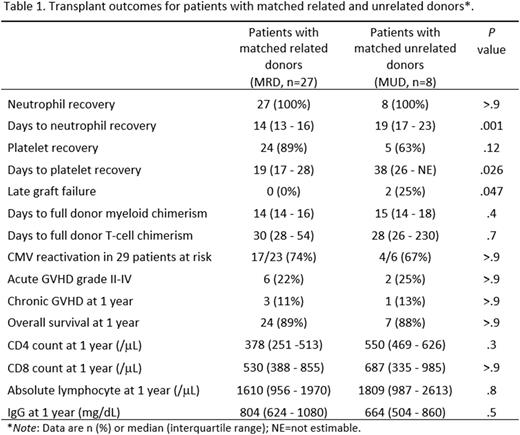Abstract
Background Severe aplastic anemia (SAA) patients who fail immunosuppressive therapy (IST) may be candidates for curative allogeneic hematopoietic stem cell transplantation (HCT). Patients with SAA are often heavily transfused with underlying immune-mediated disease, which increases their risk for graft rejection when bone marrow (BM) is used as a graft source. Peripheral Blood Stem Cell (PBSC) grafts have been associated with better engraftment but at a cost of a higher incidence of graft-versus-host disease (GVHD). We developed a novel protocol combining high numbers of GCSF-mobilized CD34+ peripheral blood stem cells with a BM transplant-equivalent dose of T-cells (collected from donors before GCSF administration) to improve engraftment and decrease the risk of GVHD associated with a conventional, unmanipulated PBSC HCT.
Methods In this phase II trial, eligible patients included those age 4-80 years with a diagnosis of SAA or other bone marrow failure (BMF) syndromes with ≥ 9/10 HLA-matched related (sibling/family) donors (MRD) or 10/10 matched unrelated donors (MUD). All patients received conditioning with cyclophosphamide (day -7 to -6), anti-thymocyte globulin (day -5 to -2), and fludarabine (day -5 to -1). For MUD patients, low dose total body irradiation (200 cGy) was added to the regimen on day -1. GVHD prophylaxis included cyclosporin (day -4 until at least day +30) and methotrexate (5 mg/m2 , day +1, +3 and +6). The primary outcome of the study was chronic GVHD at 1 year. Secondary outcomes included mortality, engraftment and chimerism, acute and chronic GVHD, immune reconstitution, and comparisons of MRD vs. MUD patients.
Results Thirty-five patients (27 with MRD and 8 with MUD) were transplanted between February 2011 and December 2021. Patients had a median age of 30 (range 6-70) years, 46% were males and 54% were females, including 31 having SAA, 3 with SAA transformed to myelodysplastic syndrome (MDS), and one with MDS; 11 patients also had PNH clone pre-transplant. The median numbers of transplanted CD34+ and CD3+ T-cells were 8 ´ 106 cells/kg and 2 ´ 107 cells/kg, respectively. After HCT transplants, all patients had neutrophil recovery with a median 14 (10-32) days. Except for 2/35 (6%) patients having late graft failure, all other 33 (94%) patients achieved sustained engraftment. Platelet recovery was reached in 29 (83%) patients at a median 19 (13-321) days. A total of 97% of patients achieved >95% donor myeloid chimerism (median 14 days), and 94% of patients achieved >95% donor T-cell chimerism (median 30 days). Reactivation of CMV occurred in 21/29 (72%) patients at risk with none developing CMV disease. Full immune reconstitution occurred for most patients by 1-year post-transplant. With a median follow-up of 5 years, the estimated 200-day survival and overall survival were 89% and 85%, respectively. The cumulative incidence of acute grade II-IV GVHD was 23%, and 1-year chronic GVHD rate was 11%, which was significantly lower than our hypothesis that this regimen would lower the chronic GVHD rate to 50% (P < .001). The subgroups of patients with MRD and MUD were compared (Table 1): patients with MUD showed a slower time to achieve neutrophil recovery (P = .001) and platelet recovery (P = .03), and a slightly high graft failure incidence (2 cases), but most other outcomes were similar, compared to patients with MRD.
Conclusion For patients with SAA and other BMF syndromes, transplanting high doses of mobilized CD34+ selected cells from MRD and MUD donors combined with a bone marrow transplant equivalent of non-mobilized donor T-cells (a partially T-cell depleted PBSC transplant) achieves rapid and durable donor engraftment and excellent survival. The cumulative incidence of both acute and chronic GVHD with this regimen was significantly lower than that historically reported with conventional PBSC transplants. Notably, low acute and chronic GVHD rates were also achieved in SAA patients with disease refractory to conventional IST who received a graft from a 10/10 HLA-matched MUD donor, although hematopoietic recovery was slightly delayed compared to recipients of a partially T-cell depleted graft from a MRD donor.
Disclosures
No relevant conflicts of interest to declare.
Author notes
Asterisk with author names denotes non-ASH members.


This feature is available to Subscribers Only
Sign In or Create an Account Close Modal